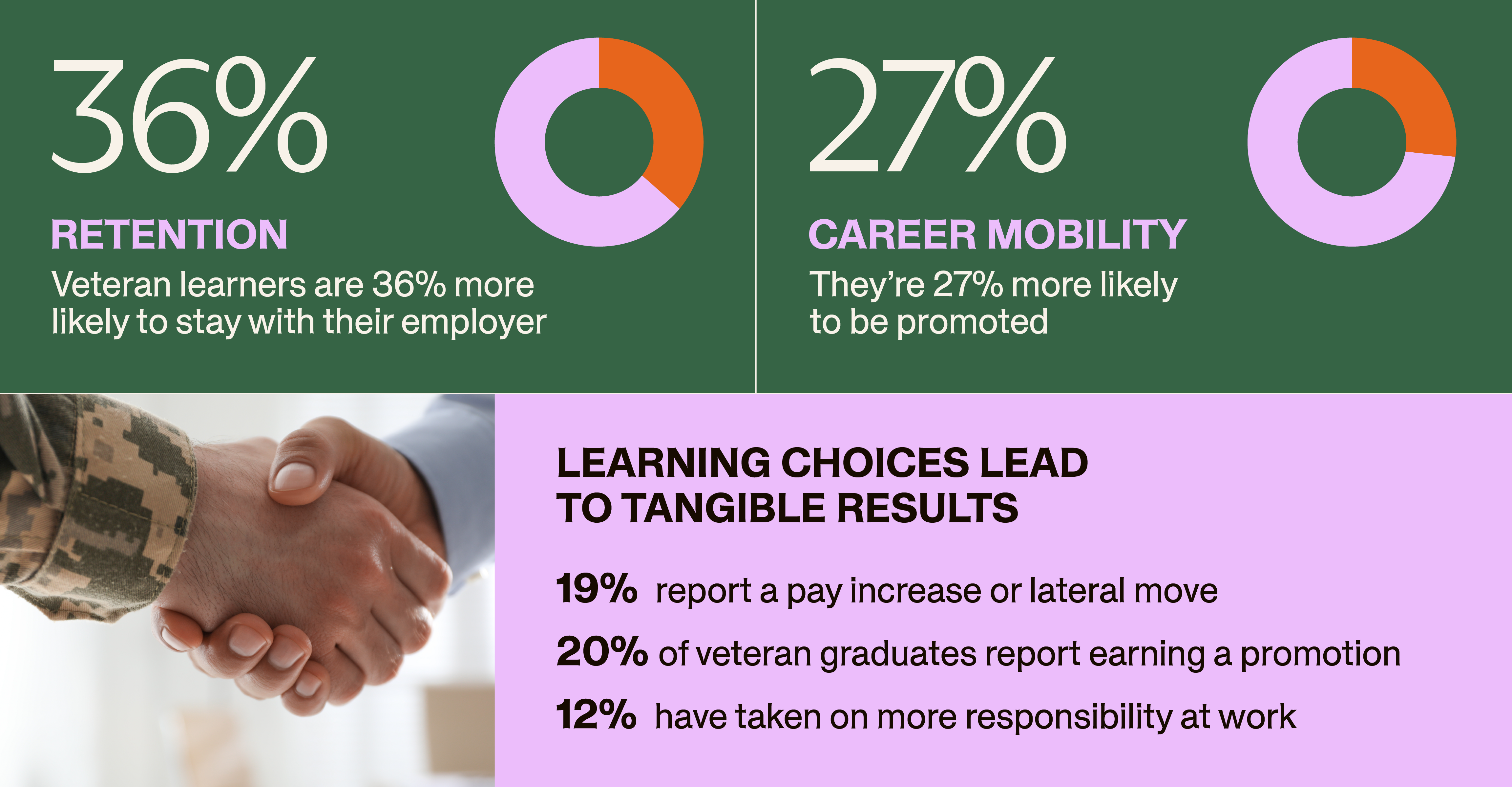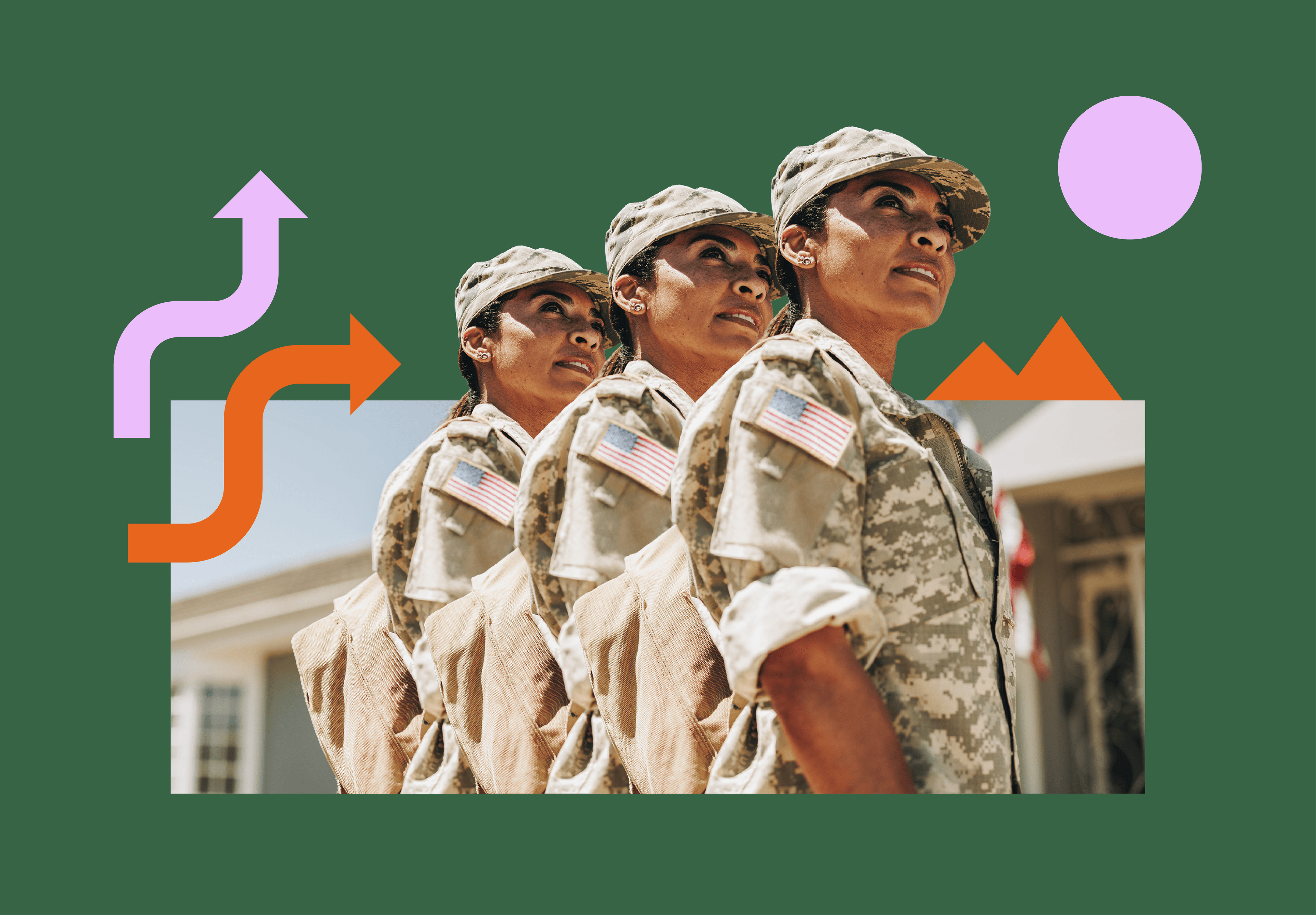Kelli Billstein |
Tiffany D. analyzes the screen in front of her, searching for ways to optimize data systems with her team. A U.S. Army veteran-turned-Data Engineer at Tyson Foods, she brings the same discipline, adaptability, and focus she honed during her military service to every challenge she takes on.
Tiffany began her civilian career at Tyson in a data-entry role. She worked hard to carve a career path, constantly recalibrating and learning new skills. Soon after enrolling in a software engineering program through Tyson’s partnership with Guild, she found a way to put those new skills to work automating a time-consuming process that had long burdened her team. That initiative earned her a promotion to the application development team before she even finished her degree.
After every pivot — from the military to civilian career to each new role at Tyson — Tiffany has drawn on the resilience she honed during her service.
“It definitely helps with discipline, resilience, pursuing through the hard things,” she says.

Resilience is the ability to adapt, evolve, and stay mobile. It means learning new skills, pivoting into new roles, and responding to change with focus and resolve. Veterans bring that resilience to every organization they join. And when employers invest in their growth, that resilience scales — strengthening teams, leadership, and the organization as a whole.
The missed opportunity
Many organizations understand the value of hiring veterans but underestimate the impact of developing them. Military experience is often recognized at hire but rarely nurtured through structured growth. According to LinkedIn, veterans are half as likely to reach director or vice president roles as their nonveteran peers, despite having nearly twice the work experience.
For some employers, veteran hiring is the finish line. In reality, it should be the starting point, because the resilience veterans bring can compound across a company when it’s nurtured, not just celebrated.
As Cory Boatwright, Senior Advisor at Hiring Our Heroes, explains, “Veterans are trained to assess situations, make decisions with incomplete information, and keep teams moving forward. When employers don’t recognize or invest in those abilities, they miss the chance to build teams rooted in trust and shared purpose.”
Veterans who learn to translate their existing skills while continuing to develop new ones bring that value back into the workplace — strengthening teams, elevating leadership, and deepening continuity. It’s the resilience payoff that most companies don’t yet measure or know they’re missing. That gap in development isn’t just a missed opportunity for veterans; it’s a competitive liability for employers.
Why resilience is the new business imperative
With the relentless pace of change across industries — as AI and other market disruptions reshape work — resilience has become a business imperative. Guild’s recent “Talent Resilience Index (TRI)” report measures workforce adaptability and mobility across the U.S. labor market, showing that organizations with high talent resilience are best equipped to bend and flex through disruption. But resilience at the organizational level only works if it exists at the employee level first.
Enter, veterans. They bring that capability with them — and they’re filling roles that anchor critical industries in the broader economy, too.
“Veterans are trained to assess situations, make decisions with incomplete information, and keep teams moving forward. When employers don’t recognize or invest in those abilities, they miss the chance to build teams rooted in trust and shared purpose.”
- Cory Boatwright, senior advisor, Hiring Our Heroes
McKinsey’s research finds that the occupations veterans are most concentrated in tend to be more future-proof roles like nursing, logistics, and operations management. Meanwhile, Guild’s TRI report identifies those same roles among the nation’s most resilient — positions that remain vital even as automation and AI reshape work. And LinkedIn’s 2023 Veteran Opportunity Report reinforces the picture: eight of the ten most in-demand skills today — leadership, communication, management, critical thinking, and problem-solving among them — are skills veterans already possess.
When companies recognize and grow that resilience, the gains are measurable for both veterans and the organizations that employ them.
The proof: What happens when veterans are invested in
For employers investing in veteran learning, the results are striking. Guild’s analysis of more than 15,000 veteran and military learners across our employer partners shows a clear difference between veterans who enroll in Guild programs and those who do not.
Veterans learners are 36% more likely to stay with their employer and 27% more likely to be promoted than veteran learners who haven’t enrolled in Guild programs.
These results show what investment makes possible: Veterans who learn through Guild are strengthening teams, driving mobility, and deepening leadership across their organizations. It’s proof that when learning scales, so does resilience.
What veterans learn
Guild data shows a clear pattern in the skills veterans choose to develop. Learners most often strengthen capabilities like management, communication, finance, critical thinking, and strategic decision-making — skills that expand their influence and help organizations stay adaptable. These are the durable, transferable skills that prepare veterans to lead teams and navigate change.
Where veterans are choosing to grow
Learners with self-reported military service are most concentrated in Business Administration (17%), Information Technology (15%), Corporate Business Functions (15%), and Data, Analytics & Statistics (10%), with another 12% pursuing healthcare disciplines. Veterans are building strength in the very areas where organizations are trying hardest to evolve — AI, analytics, management, and care delivery.
The outcomes of that investment
Those learning choices translate directly to mobility and growth: 20% of surveyed veteran graduates report earning a promotion, 19% report a pay increase or lateral move, and 12% have taken on more responsibilities at work. And 92% would recommend Guild to other veterans at their employer, a powerful signal of trust in both the process and the payoff.
Veteran learners aren’t just advancing in their own careers; they’re reinforcing the skills that make their organizations stronger, more agile, and more resilient.
Veterans’ growth driving big impact, by industry sector
Healthcare: +14% retention; +29% promotion
Manufacturing, Transportation & Logistics: +18% retention; +35% promotion
Retail: +50% retention; +35% promotion
In the sectors that keep the economy running — logistics, manufacturing, and retail — veteran learners who have enrolled in or graduated from Guild programs stay longer and move up faster than veterans at the same companies who are interested in Guild but do not enroll in programs. These industries face the toughest talent shortages and the highest stakes for building internal pipelines. Investing in veteran learning isn’t just good for workers; it’s a direct strategy for strengthening continuity and leadership within essential workforces.
Tiffany’s story brings the data to life, embodying the outcomes we see across Guild’s data on veteran learners. Through Tyson’s partnership with Guild, Tiffany is pursuing her bachelor’s in software engineering. Her learning has led to real advancement and impact — proof of how investing in veterans multiplies resilience.
A tactical playbook for employers
Guild’s learner data across industries, combined with employer best practices, consistently point to five moves that make a measurable difference in developing adaptable, future-ready teams. Each is grounded in evidence that mobility and learning lead directly to retention, advancement, and organizational strength.
Here’s how to start building on the resilience veterans already bring:
Translate military skills at hire and during internal moves.
Owner: Talent Acquisition and HR Business Partners
Metric: Increased roles with skill profiles; reduction in degree requirements
Provide education benefits that enable veterans to upskill, grow, and receive credit for prior military learning.
Owner: Learning & Development
Metric: Course completion, promotion velocity, manager effectiveness
→ Check out Guild Grow’s capabilities in supporting this tactic.
Build visible internal career pathways and marketplaces.
Owner: HR Tech and People Ops
Metric: Internal fill rate, time-to-role, cross-function moves
→ See how Guild Navigator enables this tactic.
Equip managers to sponsor and develop veteran talent.
Owner: People Managers and ERG Partners
Metric: 90-day retention post-move, engagement
Measure growth and retention as indicators of resilience.
Owner: People analytics
Metric: Mobility rate, redeployment rate, role coverage in resilient jobs, retention deltas
→ Download Guild’s TRI report to go deeper on resilience.
Resilience isn’t built from scratch. It’s already walking your halls. The question is whether you’re doing enough to help it grow.



